#medicinal traditions in india
Text
Ayurvedic Herbal potli | Massage therapy | Veda5 wellness
If you enjoy receiving massages, there’s a high chance that you may have come across potli massage therapy. You may have believed that this was just another service offered by spas. In reality, this age-old technique is one of the most effective and widely-used ayurvedic remedies for pain. Potli massage therapy has also been celebrated as a helpful solution for alleviating pain that accompanies illnesses like Rheumatoid Arthritis, Spondylitis, and even Osteoarthritis.



#Potli massage#Ayurveda and Wellness Products#Ayurveda and Herbal wellness products#massage therapy#ayurvedic potli#herbal potli#pain relief#Panchakarma treatment#wellness#muscle pain#natural ingredients#ayurvedic potli massage#Herb Healing Potli#ayurvedic massage treatment#medicinal traditions in india#potlis from Veda5#massage therapy at home#Balances dosha#ayurvedic body massage oil#Ayurvedic Luxury Brand
0 notes
Text
Trusted & Best Ayurvedic Brands in India - Hakimi Shifakhana

Ayurvedic medicine is the best to cure very long diseases without leaving any ill effect on the human body. Hakimi Shifakhana is the Trusted & Best Ayurvedic Brands in India that help you with best suggestion. Want to start a healthy lifestyle the contact Hakimi Shifakhana today, Visit the website for details: https://hakimishifakhana.com/our-doctor/
Follow Us:-
Facebook: https://www.facebook.com/HakimiShifaKhana01
Instagram : https://www.instagram.com/hakimsadiq52/
Twitter: https://twitter.com/HakimiShifakha1
YouTube: https://www.youtube.com/channel/UCR5ZfPmJgImIvVhaDMoK7eg
LinkedIn: https://www.linkedin.com/in/hakimi-shifakhana/
GMP: https://goo.gl/maps/oD5evGuLsQPXYTkg6
2 notes
·
View notes
Text
youtube
#Medical Consultation &Treatment in India for International Patientsthrough Buddha Healthcare#Indians have access to some of the top hospitals and physicians in the world. They can also receive therapies that are unavailable elsewher#homoeopathy#naturopathy#and traditional Chinese medicine are among India's most prevalent forms of medical care. People frequently utilise these alternative medici#influenza#and headaches.#Additionally#they are utilised to treat cancer and heart disease#which are significantly more severe illnesses. Indians have access to some of the most advanced medical procedures and technologies. India#for instance#has some of the greatest cancer facilities in the world and is developing numerous innovative cancer treatments.#Medical Consultation in India: Medical care in India has advanced significantly during the past several years. Patients today have numerous#whether they prefer conventional or alternative treatments. Ayurveda is one of India's most prominent traditional medical practices.#Ayurveda is a medical system founded on the principle that the body should be in equilibrium. It employs numerous strategies to restore bal#Treatment in India for International Patients:#International patients are increasingly interested in receiving medical treatment in India. This is because the quality of care is comparab#The country has many highly skilled physicians and nurses#and the facilities are modern and well-stocked. In addition#the Indian government is investing heavily in the health care system#which makes treatments more affordable.#Numerous types of medical care are available in Buddha Health care#from cosmetic surgery to heart surgery. International patients can receive the care they require since expenses are minimal and the quality#Get More Details:Online Consultation for Treatment and Medicines in India#Youtube
0 notes
Text
in addition to being prone to an obvious naturalistic fallacy, the oft-repeated claim that various supplements / herbs / botanicals are being somehow suppressed by pharmaceutical interests seeking to protect their own profits ('they would rather sell you a pill') belies a clear misunderstanding of the relationship between 'industrial' pharmacology and plant matter. bioprospecting, the search for plants and molecular components of plants that can be developed into commercial products, has been one of the economic motivations and rationalisations for european colonialism and imperialism since the so-called 'age of exploration'. state-funded bioprospectors specifically sought 'exotic' plants that could be imported to europe and sold as food or materia medica—often both, as in the cases of coffee or chocolate—or, even better, cultivated in 'economic' botanical gardens attached to universities, medical schools, or royal palaces and scientific institutions.
this fundamental attitude toward the knowledge systems and medical practices of colonised people—the position, characterising eg much 'ethnobotany', that such knowledge is a resource for imperialist powers and pharmaceutical manufacturers to mine and profit from—is not some kind of bygone historical relic. for example, since the 1880s companies including pfizer, bristol-myers squibb, and unilever have sought to create pharmaceuticals from african medicinal plants, such as strophanthus, cryptolepis, and grains of paradise. in india, state-created databases of valuable 'traditional' medicines have appeared partly in response to a revival of bioprospecting since the 1980s, in an increasingly bureaucratised form characterised by profit-sharing agreements between scientists and local communities that has nonetheless been referred to as "biocapitalism". a 1990 paper published in the proceedings of the novartis foundation symposium (then the ciba foundation symposium) spelled out this form of epistemic colonialism quite bluntly:
Ethnobotany, ethnomedicine, folk medicine and traditional medicine can provide information that is useful as a 'pre-screen' to select plants for experimental pharmacological studies.
there is no inherent oppositional relationship between pharmaceutical industry and 'natural' or plant-based cures. there are of course plenty of examples of bioprospecting that failed to translate into consumer markets: ginseng, introduced to europe in the 17th century through the mercantile system and the east india company, found only limited success in european pharmacology. and there are cases in which knowledge with potential market value has actually been suppressed for other reasons: the peacock flower, used as an abortifacient in the west indies, was 'discovered' by colonial bioprospectors in the 18th century; the plant itself moved easily to europe, but knowledge of its use in reproductive medicine became the subject of a "culturally cultivated ignorance," resulting from a combination of funding priorities, national policies, colonial trade patterns, gender politics, and the functioning of scientific institutions. this form of knowledge suppression was never the result of a conflict wherein bioprospectors or pharmacists viewed the peacock flower as a threat to their own profits; on the contrary, they essentially sacrificed potential financial benefits as a result of the political and social factors that made abortifacient knowledge 'unknowable' in certain state and commercial contexts.
exploitation of plant matter in pharmacology is not a frictionless or infallible process. but the sort of conspiratorial thinking that attempts to position plant therapeutics and 'big pharma' as oppositional or competitive forces is an ahistorical and opportunistic example of appealing to nominally anti-capitalist rhetoric without any deeper understanding of the actual mechanisms of capitalism and colonialism at play. this is of course true whether or not the person making such claims has any personal financial stake in them, though it is of course also true that, often, they do hold such stakes.
535 notes
·
View notes
Text
Nasal COVID-19 vaccine halts transmission - Published July 31, 2024
Study in hamsters indicates vaccines targeting nose, mouth may be key to controlling spread of respiratory infections
A nasal COVID-19 vaccine blocks transmission of the virus, according to an animal study by researchers at Washington University School of Medicine in St. Louis. The findings suggest that vaccines delivered directly to the nose or mouth could play a critical role in containing the spread of respiratory infections.
The lightning-fast development of COVID-19 vaccines just months after the virus appeared was a triumph of modern science and saved millions of lives. But for all the good they did in reducing illnesses and deaths, the shots were unable to end the pandemic because of one notable weakness: They couldn’t stop the spread of the virus.
A new study by researchers at Washington University School of Medicine in St. Louis indicates that next-generation vaccines that target the virus’s points of entry — the nose and mouth — may be able to do what traditional shots cannot: contain the spread of respiratory infections and prevent transmission. Using a nasal COVID-19 vaccine based on Washington University technology, approved for use in India and licensed to Ocugen for further development in the U.S., the researchers showed that vaccinated hamsters that developed infections did not pass the virus on to others, breaking the cycle of transmission. In contrast, an approved COVID-19 vaccine that is injected failed to prevent the spread of the virus.
The findings, published July 31 in Science Advances, provide further evidence that so-called mucosal vaccines sprayed into the nose or dropped into the mouth may be the key to controlling respiratory infections such as influenza and COVID-19 that continue to circulate and cause significant illness and death.
“To prevent transmission, you need to keep the amount of virus in the upper airways low,” said senior author Jacco Boon, PhD, a professor of medicine, of molecular microbiology and of pathology & immunology. “The less virus that is there to begin with, the less likely you are to infect someone else if you cough or sneeze or even just breathe on them. This study shows that mucosal vaccines are superior to injected vaccines in terms of limiting viral replication in the upper airways and preventing spread to the next individual. In an epidemic or pandemic situation, this is the kind of vaccine you’re going to want.”
Developing vaccines that can control virus levels in the nose has proven challenging. Viruses such as influenza virus, SARS-CoV-2 (the virus that causes COVID-19) and respiratory syncytial virus (RSV) multiply rapidly in the nose and spread from person to person within a few days of initial exposure. Traditional injectable vaccines generate immune responses that can take a week to build to full strength and are much less potent in the nose than in the bloodstream, leaving the nose relatively unprotected against a fast-multiplying, fast-spreading virus.
In principle, a vaccine sprayed or dropped directly into the nose or mouth could limit viral reproduction and thereby reduce transmission by eliciting an immune response right where it’s needed most. But gathering evidence that mucosal vaccines actually do reduce transmission has proven tricky. Animal models of transmission are not well-established, and tracking person-to-person transmission is fiendishly complicated, given the number and variety of encounters a typical person has on any given day.
For this study, Boon and colleagues developed and validated a model for community transmission using hamsters and then used it to assess the effect of mucosal vaccination on the spread of SARS-CoV-2. (Unlike mice, hamsters are naturally susceptible to infection with SARS-CoV-2, making them the ideal laboratory animals for a transmission study.)
The researchers immunized groups of hamsters with laboratory versions of approved COVID-19 vaccines: the nasal iNCOVACC used in India or the injected Pfizer vaccine. For comparison, some hamsters were not immunized. After giving the vaccinated hamsters a few weeks for their immune responses to fully mature, the researchers infected other hamsters with SARS-CoV-2 and then placed the immunized hamsters with the infected hamsters for eight hours. This first step of the experiment mimics the experience of vaccinated people who are exposed to a person with COVID-19.
After spending eight hours rubbing shoulders with infected hamsters, most of the vaccinated animals became infected. Virus was found in the noses and lungs of 12 of 14 (86%) hamsters that had received the nasal vaccine, and 15 of 16 (94%) hamsters that had received the injected vaccine. Importantly, while most animals in both groups were infected, they weren’t infected to the same degree. Hamsters that had been nasally immunized had virus levels in the airways 100 to 100,000 times lower than those that had received the shot or had not been vaccinated. The study did not assess the animals’ health, but previous studies have shown that both vaccines reduce the likelihood of severe illness and death from COVID-19.
The second step of the experiment yielded even more striking results. The researchers took vaccinated hamsters that subsequently developed infections and placed them with healthy vaccinated and unvaccinated hamsters for eight hours to model transmission of virus from a vaccinated person to others.
None of the hamsters that were exposed to nasally vaccinated hamsters became infected, regardless of whether the recipient hamster had been vaccinated or not. In contrast, roughly half of the hamsters that were exposed to hamsters vaccinated by injection became infected — again, regardless of the recipient’s immunization status. In other words, vaccination through the nose — but not by injection — broke the cycle of transmission.
These data, Boon said, could be important as the world prepares for the possibility that avian influenza, currently causing an outbreak in dairy cows, might adapt to humans and trigger a flu epidemic. An injectable vaccine for avian influenza already exists, and a team of researchers at Washington University is working toward a nasal vaccine for avian influenza. That team includes Boon and co-author Michael S. Diamond, MD, PhD, the Herbert S. Gasser Professor of Medicine and one of the inventors of the nasal vaccine technology used in this paper.
“Mucosal vaccines are the future of vaccines for respiratory infections,” Boon said. “Historically, developing such vaccines has been challenging. There’s still so much we don’t know about the kind of immune response we need and how to elicit it. I think we’re going to see a lot of very exciting research in the next few years that could lead to big improvements in vaccines for respiratory infections.”
Study linked in the first link!
#covid#mask up#pandemic#covid 19#coronavirus#wear a mask#sars cov 2#still coviding#public health#wear a respirator
218 notes
·
View notes
Text

The 7 Ancient Planets
Since ancient times there have been 7 Ancient Planets: Saturn, Jupiter, Mars, Venus, Mercury with the Sun and Moon being also classed as Planets (or more correctly, Celestial Bodies). These 7 Planets were known to many ancient cultures and the Planets had energies applied based on their size, color, distance, speed of motion etc. Curiously, the Sumerians knew of these 7 planets plus another within our solar system which appears where the asteroid belt is.
The knowledge of the 7 Planets was blended with the Theory of the Elements and Medical theory at an early time. There are 2 ways we can look at it:
Western, Four Element: Saturn is Earth, Jupiter is Air, Venus is Water and Mars is Fire, the Sun being Yang (ultimate Fire) and the Moon Yin (Ultimate Water). Mercury is in the Center as Balance.
Eastern, Five Element: As above, but Mercury is Metal
Each planet has associations based on the Elements, Organs and Humors:
Saturn is associated with the Earth, Spleen and Melancholy
Jupiter with Air (Wood), Liver, Metabolism and Blood
Mars with Fire, Heart, Circulation and Bile
Venus with Water, Kidney, Fluid and Phlegm
Mercury is associated with balance
Sun with Fire, Heart and Yang
Moon with Water, Kidneys and Yin
So an Herb assigned to Jupiter will tend to nourish Liver and Blood, and so with the other Planets.
Each Day of the Week is also assigned to a Planet from which their names are derived:
Sunday–Sun
Monday–Moon
Tuesday–Mars
Wednesday–Mercury
Thursday–Jupiter
Friday–Venus
Saturday–Saturn
A Lunar herb is best collected on the day of the Moon (Monday), and so with the other planets. Also, a cool herb could be more Yin tonic in nature if collected on a Monday, as compared to if collected on a Saturday which may be better to clear Heat and Damp.
The day was also divided into equal proportions between sunrise and sunset, with each period being allocated a planet. So the first hour after sunrise on Sunday is allocated to the Sun, the next the Moon, and so on throughout the day. So a Lunar herb is best collected on Monday, and in the hour of the Moon.
Later, this was taken further, and the Natal (Birth) chart was used to ascertain weaknesses in the Chart which could be treated or prevented with appropriate Medicine. Medical Astrologists would look for weaknesses in the Birth chart and aim to strengthen them with medicines. Even today in India, certain Healers study the Birth chart for weaknesses, then prescribe a particular Gem stone to be worn on a particular finger to restore balance. Each planet has an associated color, and stones of that color were associated with the planet.
Astrology and the energetics associated with the Planets is just another method of energetic correspondence that was used by the Ancients to better understand and work with the Universe they lived in.
97 notes
·
View notes
Text
(Spawned by this post and done separately bc I didn't want to derail.)
Folk magic traditions and folk medicine, historically speaking, tend to rely heavily on regionally-available resources. Whatever was growing in their particular biome was what got used. So we see many many plants with overlapping usages or correspondence. And it may SEEM repetitive in an age where we can source pretty much whatever we want or need from the internet or from local stores that import herbs and spices.
White sage and palo santo are excellent examples, but we can also look at things that are closer to home. Consider, for instance, the humble peppercorn.
Native to the India, black pepper is one of the oldest known spices in the world, with usage records going back over 5000 years, and is a staple ingredient in most household spice cabinets. Even the blandest, most white-bread kitchens will at least have salt and pepper on hand, and pepper has a plethora of magical uses from protection to cleansing to fertility to warding off bad luck and malefic magic.
AND YET. Black pepper used to be the most expensive spice in the western world. Literally worth its' weight in gold in the ancient, classical, and medieval periods. It was used by physicians to treat a variety of digestive complaints and was believed to reverse the effects of certain poisons. It was so valuable, people used to pay their rent with it, much in the way that Roman soldiers once received salt as part of their wages. It wasn't until the Renaissance that black pepper started to be affordable for an average household as trade expanded and other substances like coffee, cocoa, and saffron gained in popularity.
So we might easily reach for a courtesy pepper packet for a quick banishing or protection ritual today, but that's not something the average medieval English peasant looking to ward off bad luck or keep evil spirits out of their house would have access to. But what they DID have was rowan trees. And we see many references in the folk magic of the British Isles to rowan boughs or rowan berries being using for protection, fertility, cleansing, and the warding-off of misfortune and magical harm.
So instead of going right for the white sage or palo santo, why not try smoke-cleansing with rosemary and bay leaf? They have the same magical properties and are much more affordable and readily available, plus that added bonus of, yanno, avoiding culturally appropriative or overharvested plants.
Anyway, point is, widespread availability is all well and good, but you'd be surprised just how much you can find in your own backyard and how useful it can be in your craft.
461 notes
·
View notes
Text
Theory on that Crimson Jimson-Weed;
So I was re-watching "To Catch a Leaf" like any good Sandy-fan when I recognised the name of the flower (Crimson Jimsonweed/Scarlet Mandala flower) being something I encountered in my horticulture/pharma studies;

You see, Jimsonweed is another name for Datura - a super-toxic nightshade flower known for it's psychoactive effects that was occasionally used in traditional Chinese medicine. A few seeds or leaves is enough to send someone into days-long potentially fatal delirium. Monk in India particularly used it to induce horror/madness in order to have a better understanding of the world.
My first thought was; "Why tf would Sandy reccomend a flower that's like a million acid trips in one?" and second "Why did LBD need it?"
According to Sandy the Crimson Jimsonweed can "influence mortality itself" - something that would be very useful if your opponent is someone who's pretty protective of their immortality. NO wonder why LBD was pissed. Huntsman "only" taking a single petal could have saved the gang's lives in the long run.
And I thought: "Cool!"
And then I was researching an au idea/theory @dorothygale123 brought up about "Shennong/The Flame Emperor/Divine Peasant" having connections to the Demon Bull King and Red Son; only to read how he (a primordial god of fire and medicine) died;


You see, after he retired/lost the godly throne, Shennong decided to put his brain and super-durable/transparent stomach to use and self-experiment on himself and document the results. He apparently got poisoned quite a lot in his research (he also discovered many ways to get high) to classify all plant life.
Ultimately Shennong died after eating a "small yellow flower" and being unable to find an antidote or "clean out his instestine" in time. Kind of a sad but expected end to the chinese mythos version of the first farmer-scientist. A rule of medicine is that anything that can heal can also kill at a certain dosage.
But the flower that killed him is up for debate. The book I have suggests it to be "Intestine-Breaking/Heartbreak Grass"(Gelsemium sempervirens). This Oxford paper suggests Tansy, an old treatment for worms. But a common theme is that the "flower of a weed" was the cause.
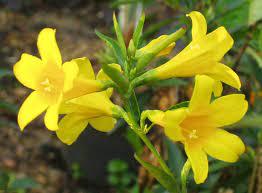
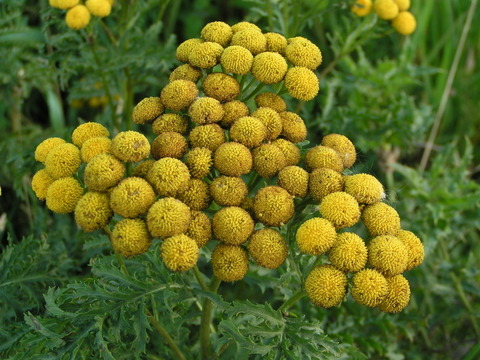
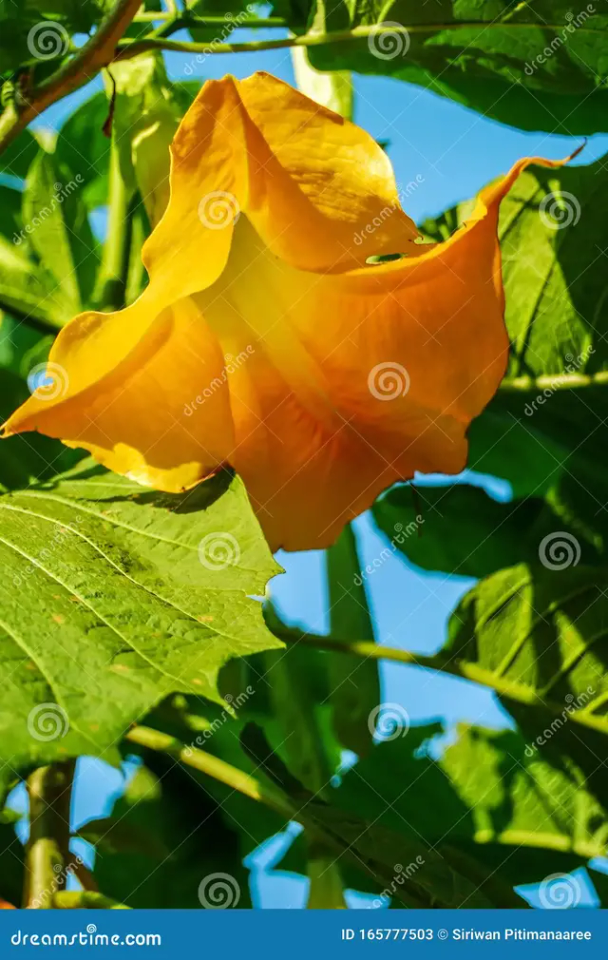
After my research into Jimsonweed and it's connections to mortality in Buddhism I must suggest a hidden culpurit;
This could be my mild red-colourblindness acting up; but The flower we see throughout the "To Catch a Leaf" is gotdamn yellow.

The flower that can "influence mortality itself" would be the perfect candiate for what killed the legendary Divine Peasant.
Makes sense why Sandy decided to instead brew a very small part of it into tea for MK. He likely read Shennong's research and realised that this super-rare variant of Jimsonweed *was* an amazing tonic... in the right dosage of course. Hence why Sandy didn't feed MK the whole flower.
#shennong#lmk shennong#the flame emperor#the divine farmer#lmk character ideas#lmk sandy#lmk to catch a leaf#lmk huntsman#lmk#lego monkie kid#lmk theories#chinese mythology#lmk aus#horticulture is fun
74 notes
·
View notes
Text
CoD The Other Good Guys Bear! Edition
What if the rest of the good guys in call of duty were bears? Part 2 - see Part 1 for 141 as bears
More bear facts! Cause bears are truly the best! 🐻💯
Alejandro: Mexican Grizzly Bear*
Ursus arctos nelsoni - now Ursus arctos horribilis

*depiction of what a mexican grizzly bear may have looked like alive
A now extinct subspecies of the grizzly bear that once inhabited northern Mexico. Due to its predation on cattle farms, they were considered pests and hunted by farmers. By the 1960s there were less than 30 individuals remaining. In 1974 the last known individual was shot in Sonora.
It was smaller than grizzly bears from the United states and Canada, and its colouration was said to range from a pale yellow to greyish-white with a darker undertone, though some individuals were described to be darker and reddish brown.
Due to its silvery fur, it was called 'el olso plateado' (the silvery bear) in Spanish, though it's name in the Ópatas language (an indigenous Mexican people's) was 'pissini'.
Rudy: Spectacled Bear "Andean Bear"
Tremarctos ornatus

The last remaining short-faced bear, native to the Andes Mountains in northern and western South America. Though all bears are omnivores, the spectacled bear has a mostly herbivorous diet with only 5-7% of their diet being meat.
The bear is named after it's distinctive eye markings, though not all spectacled bears may have such markings. Individuals can have highly variable fur patterns making it relatively easy to distinguish from one another.
It's short face and broad snout is thought to be an adaptation to a carnivorous diet despite it's herbivorous preferences.
Paddington Bear is said to be a Spectacled Bear from Peru.
Farah: Asian Black Bear "Moon Bear"
Ursus thibetanus

A medium sized bear native to Asia and highly adapted to arboreal life. It can be found in parts of Korea, China, Japan, eastern Russia, the Himalayas, southeastern Iran and northern India. It is listed as vulnerable due to deforestation and poaching for its body parts (used in traditional medicines).
The name 'moon bear' is given due to its distinctive creamy white cresent fur patch, though in some individuals it is "V" shaped. It has a powerful upper body stronger than it's lower limbs and are known to be the most bipedal of bears.
It has a reputation for extreme aggression despite their reclusive nature and there have been documented reports of unprovoked attacks. They are said to be more aggressive than the Eurasian Brown Bears that may cohabit the same areas and the American Black Bear.
Alex: American Black Bear
Ursus americanus

Alongside the Brown Bear, it is one of the only Bear species not threatened with extinction.
Despite living in North America, it is more closely related to the Asian Black Bear and Sun Bear than Grizzly Bears (North American Brown Bears) and Polar Bears. It's ancestors are thought to have split off from the Sun Bear.
Black Bears are distinguished from Grizzly Bears who may cohabit the same area, with their longer tall ears, straight face profile, shorter claws and lack of distinctive hump.
Teddy bears, Winnie-the-Pooh, and Smokey Bear are all inspired by the American Black Bear.
Nikolai: Polar Bear
Ursus maritimus

A large bear native to the Arctic. It is closely related to the Brown Bear and can hybridise with them though this is rare and not often seen. (See Grolar Bears)
They are the most carnivorous of all bear species (hypercarnivores), specialising in hunting seals through ambush attacks. Polar Bears are usually solitary but can be found in groups on land. They can form stable 'alliances' based on dominance hierarchies outside of breeding seasons with the largest males at the top.
It's common name was given in 1771, and was previously referred to as 'white bear', 'ice bear', 'sea bear', 'Greenland bear' in 13th - 18th century Europe. The Netsilik cultures (Inuit) named it 'nanook' and have several additional different names for them depending on sex and age of the polar bear.
Laswell: Kodiak Bear "Kodiak/Alaskan Brown Bear"
Ursus arctos middendorffi

Named after it's habitation of the Kodiak Archipelago in southwest Alaska, the Kodiak bear is the largest subspecies of Brown Bear, with some individuals comparable to the Polar Bear in size.
An island bear, it is 1.5-2x larger than it's mainland cousins the grizzly bear, though physically and physiologically, the two bears are very similar.
Due to its tendancy to feed in dense groups, it has thought to have developed more complex social behaviours (in comparison to mainland grizzly bears) to minimise infighting/fatalities via both verbal/ body posturing and social structures.
+
All info taken from wiki. Please let me know if ther any mistakes.
#cod mwii#cod mw2#call of duty modern warfare#cod mwiii#alejandro vargas#rudy parra#rudy cod#farah karim#farah cod#alex cod#nikolai cod#kate laswell#laswell cod#bears#bear facts
31 notes
·
View notes
Text
marigolds

It's October! For half the hemisphere, the nights are getting longer, the wind is getting colder and the weather is taking on a distinct grey and overcast mood. What better time than now to steal a few last bursts of brilliant, warm sunshine and keep them close against the coming of winter?
Enter October's flower (one of them) - the marigold.
An interesting thing I found while researching this month's flower was that its native to the Americas - and yet some sites list the ancient Greeks and Romans having traditions surrounding the marigold. One of the sites even mentions the flower being introduced to the 'Americas' several sentences after telling me its native to Mexico. I think some of the confusion may come from the fact that there are marigolds of the Tagetes genus, which are the ones I think of when I think of marigolds, that were first mentioned by the Aztecs and are native to the Americas - and there is a flower, Calendula officinalis, called the 'pot marigold' which comes from the same daisy family but is a different genus and seems to originate in southern Europe. To add to the confusion, the Spanish imported the Tagetes marigold from the Americas and from Spain it spread to, particularly, monastery gardens across Europe where it was cultivated into various strains with names like the African or French marigold. The American marigold didn't even have an official genus name until 1753. So, sorting through marigold myths was a lot like playing 'guess which twin it is' for me especially since the majority of the sites I was wandering through either weren't aware of a difference or didn't differentiate. I found one site that marked the difference between them (shout out to growingvale.com). I can understand why. We're only talking flower folklore here, not nuclear codes. My little nitpicky soul though just wasn't happy until it figured out what was going on. I am now going to spew facts at you and try to tell you which flower is which for each of them.
We'll see how I do.
Let's start at the beginning.
Tagetes marigolds were first recorded as being cultivated by the Aztecs, who considered them both medicinal and sacred. That tradition has carried over into Mexico's el Día de los Muertos, the Day of the Dead, which is celebrated either in late October or Early November depending on the region. How much of that is straight from the Aztecs and how much is later European influence via Catholicism is still up for debate but the marigold plays a special part in both. The brightness and strong scent of the marigold flowers are believed to help guide the spirits of the dead to their family and to the offerings left out for them. You watched Disney's Coco (or Fox's The Book of Life), you get it. The Day of the Dead is celebrated outside of Mexico as well, with traditions varying from place to place but right now, we're talking marigolds.
In a half step to the side of that, the Victorians also considered marigolds a funeral flower but in a solemn and grief-filled way that made their cheery color inappropriate for any other kind of bouquet.
In South Asia, the Tagetes marigold has in large part replaced Calendula officinalis marigold while still serving the same purpose. There marigolds are used to create garlands and decorations for weddings, festivals and sacred holidays. Both Buddhism and Hinduism attach spiritual significance to the flowers. In India, giving a garland of marigolds to someone is considered a sign of friendship.
Walking it back to our Calendula officinalis marigold, the common name of 'marigold' is actually a break down of 'Mary's gold'. The golden colored plant was often left on alters and shrines to the Virgin Mary in Catholic countries in the middle ages by people that couldn't afford to leave actual coins. Its bright sunshine color and availability to everyone soon became associated with her.
This is the marigold that the ancient Romans and Greeks used medicinally and that medieval Europe thought was a cure against the plague. This is also the marigold that was woven into garlands for doors and livestock in Ireland to keep away fairy attention.
Both branches of flowers are popular with love superstitions, representing never having to lose a love and as a good luck charm when it comes to love.
And let's round things off with a gardening fact. Marigold are considered excellent companion plants for most vegetable gardens because they repel pests from the big to the very tiny kind. Just check before you plant. Their roots also give off an antibacterial chemical that will wreck havoc on your legumes.
Happy birthday, October babies!

#marigold#marigolds#folklore#superstition#cottagecore#herbalism#herbology#october#birth flower#day of the dead#dia de los muertos#dia de muertos#right up there with#dandelions#as a sunshine flower#flowers#language of flowers#meaning of flowers
61 notes
·
View notes
Text
What Exactly Is Sannyo Smoking?

Well of course it sucks Mamizou, don't you remember what she said it's made of?

Now, an herb you can smoke that can grow on a mountain. The first, most obvious, initial guess would be marijuana. It's a weed after all, it can grow basically anywhere. Plus, let us be honest, it would be a little funny.
marijuana can definitely grow on mountains, it even grows on mountains in Central Asia

Plus, it is apparently spreading over northern Japan right now as a weed. They used to grow it for hemp material, not to smoke, it would probably not do much, but that wouldn't stop Sannyo if she wanted to give it a shot.
(Except I'm deliberately teasing)
There is a very, very obvious reason why it's not marijuana.
Marijuana has no nicotine, even though you can smoke it, it's not by any stretch of the imagination "tobacco"
Even if we imagine a world where this is the only thing Sannyo ever smoked, Mamizou smoked it with her and just said it was bad tobacco, not to mention Mamizou has recently been to the outside world and would probably know weed in seconds. (Which, although hypothetical, would have made for a hilarious Mamizou thought bubble)
We are looking for "tobacco" after all, we need nicotine, not just anything you can smoke, but it's a weed and a popular joke, so I obviously had to tease.

I could go through every variant of wild Nicotiana, tobacco was even imported to Japan by Portuguese sailors in 1542, and it's cultivation was legalized in 1625. The Hakurei barrier was formed in 1885, that's actually plenty of time for actual wild tobacco to spread.
But it might not work either.
While we might find some enthusiastic and previously cultivated tobacco growing as a weed that spread up to the mountains, it's not going to be unique enough. It'll be growing all over the place by the time it gets up a mountain. And the village would be smoking that exact same thing.
But most importantly, it's no fun.
Truth be told, there is a genus of Nicotiana that would work well in mountains, furthermore, Portugal actually had some at the time as an import from the Americas. But thats no fun, so I'll just return to this later when I inevitably run out of exotic options.
After all, if its tobacco made from "herbs" it would boarder on cheating to just use nicotiana, regardless of the form it ends up in.
Thankfully, there are other herbs and weeds beyond nicotiana that actually have nicotine, it really would be worthwhile check one of those.
And I've got a fun one. A whole family in fact.
Just above the Genus: "Nicotiana" is the Tribe: "Nicotianeae" and above that we find the family Solanaceae.
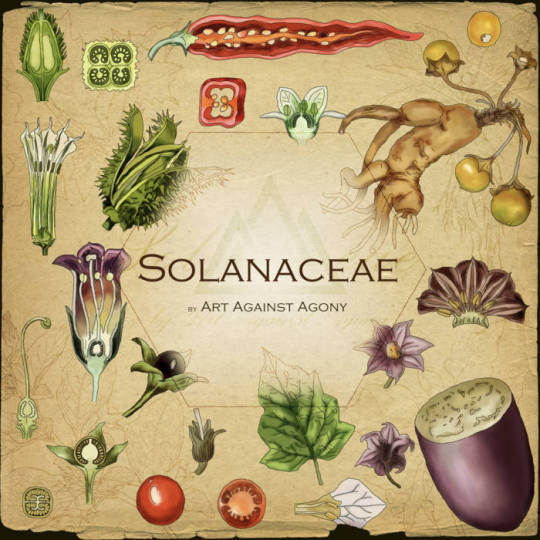
The Solanaceae, also known as the potato or deadly nightshade family
Nicotine is a naturally produced alkaloid in the nightshade family of plants
It contains everything from eggplants and other vegetables to the infamous Deadly Nightshade. (Atropa belladonna)
And of course, like I said, further down the family, it even has nicotiana itself. All of them contain nicotine to some greater or lesser extent. (Yes, hilariously even eggplants, a little bit)
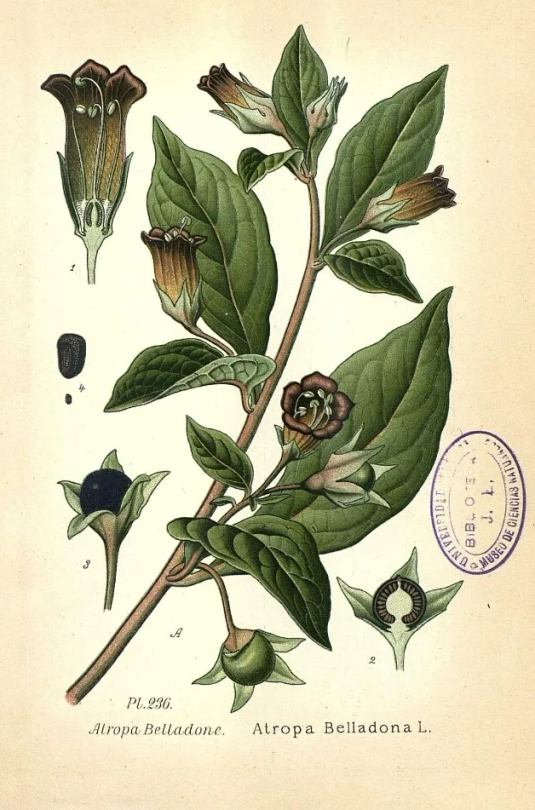
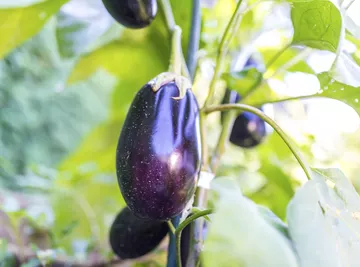
Solanaceae consists of about 98 genera and some 2,700 species. They grow naturally in more parts of the world than wild Nicotiana.
But we are just going to be looking through the nightshade variations, maybe some fruit, but no potatoes today. And these are coveniently famous for their narcotic effects.
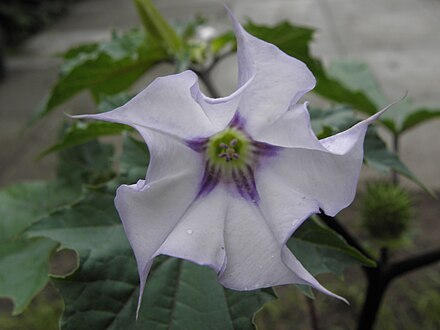
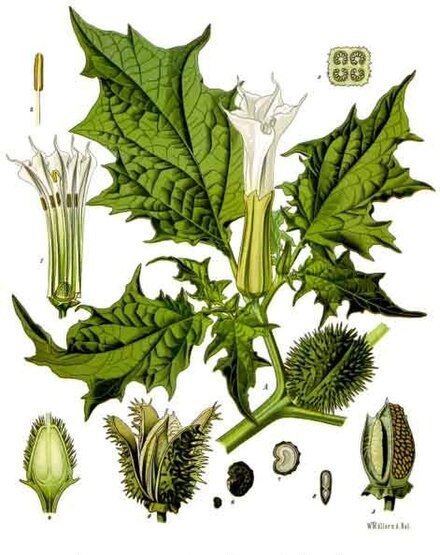
And some varieties, such as the Datura stramonium (occasionally called the Devil's Trumpet) had its leaves smoked in pipes and cigarettes, so much they were traded by the East India Company in the 18th century. And since it was popular for traditional medicine, some people might have even planted it.
But that type is not native to Japan, so it's got the same problem as the nicotiana. Not to mention, even though its an invasive weed, and can survive a little below the freezing point, in its current state, it probably doesn't like mountains. It probably wouldn't last a full winter on one.
This might be definite enough to just say it can be some hypothetical, wild, non specific variation of nightshade with the right combination of alkaloids and nicotine and presumably, relatively non deadly in the form Sannyo uses it.
Or maybe it is just better adapted to mountains form of imported of the Datura stramonium I just mentioned. I doubt even if it spread like a weed, that anyone but Sannyo would bother to figure out you can smoke that type of plant as tobacco.
But we are mostly just having fun at this point.
I doubt we could possibly think Zun cared up to this point, and definitely not beyond this point, we are just doing a fun overanalysis after all. Zun almost always seems to go for extinct species anyway, so it wouldn't be fun to follow that train of thought regardless..
[But if we just want a probable canonical answer Zun thought up. He might have just meant some non specific extinct variation of nightshade, since if there is at least one native version then that's enough to claim there could have once been others,
Besides, it's even possible zun just imagined she could possibly even mix her favorite flowers somehow, which while she probably could not, it would definitely be cute. ]
But we are going to take this further anyway to see if we can find something real and possible that currently exists today.
The simplest thing to think of native to Japan is just Japanese belladonna (Zun's proof of concept for an imaginary extinct nightshade if he really wanted a hypothetical one)
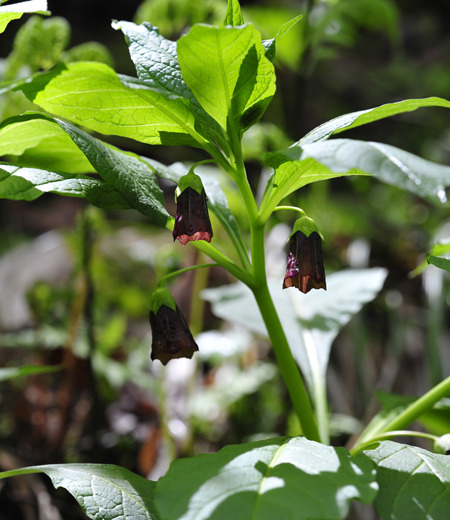
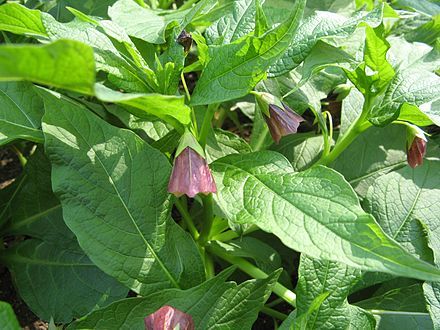
Scopolia japonica, also called Japanese belladonna. It's about as dangerous as the name implies. If eaten by mistake it can cause hallucinations. And while it no doubt contains at least some nicotine, it also contains the alkaloids Scopolamine
And more hilariously Hyoscyamine, known for helping the colon or bladder...
yes, you can use this extract to help you poop or pee if you want too.
Which is even funnier than the marijuana joke i made earlier.
And the only other species in the Scopolia genus is pretty similar and in Korea.
So we'll want to find something different.
But we are trapped. We only have imports left.
And the Datura genus we'd likely want is stuck in the Americas so we can only really consider a variety that came from those possible 18th century imports of Datura stramonium.


They are pretty perfect, tbh, spread widely to the Old World early where it has also become naturalized, and since it was already a weed that could endure dry climate and fairly cold environments. It could probably spread up a mountain.
They are our best bet for something you can smoke for recreation, with nicotine, outside the nicotiana genus that only Sannyo would use. If smoked people used its properties for recreation but you can also use it for anesthesia. Inject it's primary ingredient Atropine and you can use it for all sorts of weird stuff. (Though I pretty much resigned myself to having Atropine in the plant the moment I decided to run up and down the nightshade family).
Though in truth, she's probably just smoking wild tobacco that has lost a lot of flavor while struggling to adapt the mountain. So I'll move on to the most likely answer.
Portugal's more early tobacco is Nicotiana rustica, also called Aztec tobacco.
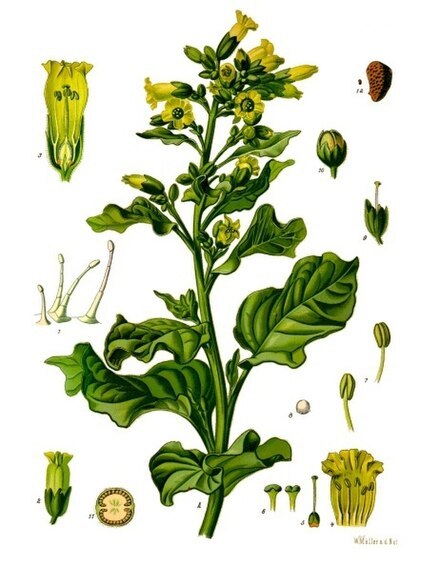
It is pretty tough and would probably adapt to a mountain pretty well.
I'd like to think it's the Datura stramonium since it's cooler and weird though.
In overview:
The simplest, best answer is just wild imported Aztec tobacco (Nicotiana rustica) from Portugal. Which had trade with Japan open up extremely early. Its honestly perfect for this

Followed by the more provocative option of Devil's Trumpet (Datura stramonium) imported later in the 18th century.

and the funny option. The only one actually native to Japan
Japanese belladonna (Scopolia japonica)

But it's almost definitely just that Aztec tobacco. (Nicotiana rustica)

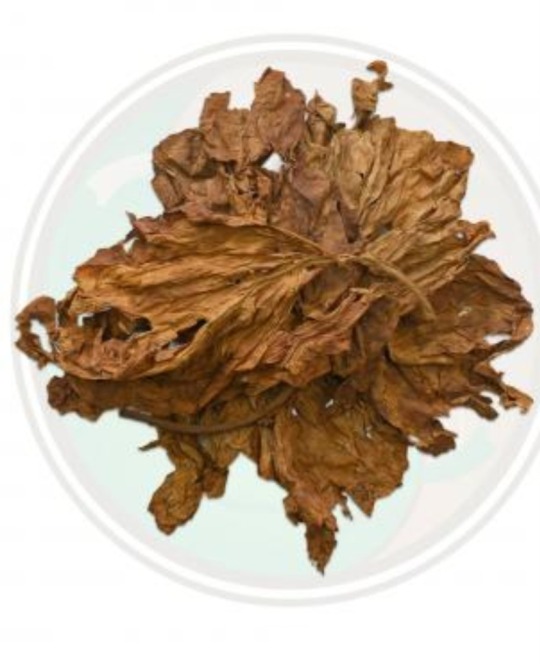
We could just imagine she mixes flowers or herbs into it to validate her "herbs" comment if we want (which again, would be cute)
#sannyo komakusa#touhou project#Flowers#Smoking#This took me collectively more than 16 hours#I had a ton of fun up until the point I realized Japan had like only one native option and was basically stuck with imports completely.#lotus eaters#It's probably just the Aztec tobacco but I felt obligated to run through looking for native nightshade#I'll need to make a short version later.#It's funny that I've imagined a world Sannyo would give smoking almost anything she comes across a shot if nicotine is involved.#mamizou futatsuiwa
34 notes
·
View notes
Text
Best Ayurvedic Brands in India - Hakimi Shifakhana

The reach of Ayurvedic medicine in India is wide since its inception, with the power of nature and herbs, we can cure many serious diseases. Hakimi Shifakhana is the best ayurvedic brands in India, know for best homemade remedies. Get more details and information here: https://hakimishifakhana.com/
Follow Us:-
Facebook: https://www.facebook.com/HakimiShifaKhana01
Instagram : https://www.instagram.com/hakimsadiq52/
Twitter: https://twitter.com/HakimiShifakha1
YouTube: https://www.youtube.com/channel/UCR5ZfPmJgImIvVhaDMoK7eg
LinkedIn: https://www.linkedin.com/in/hakimi-shifakhana/
GMP: https://goo.gl/maps/oD5evGuLsQPXYTkg6
1 note
·
View note
Text

Here’s my second piece for Sonic Garden @shadowxamyweek! Yes, I did two because why not?
Decided to step out of my comfort zone by drawing a Sonic character I don’t normally draw, as well as picking a flower many may not know a whole lot of information about. So, I figured who better to draw than Rouge with a hibiscus tucked behind her ear? A decision I’m glad I made because I absolutely enjoyed creating this and love the final product!
I’ll also quickly dive behind the scenes and say I wanted this to have a video game-esque feel. Hence the character window, dialogue box and selection arrow that are often seen and used in games. I even made Rouge’s hand, wings, ears and a bit of the hibiscus poke out and onto different areas to help give the artwork a sense of depth.
I’d also pick either SA2B’s or Sonic Prime’s VA to voice Rouge, if this was part of an actual STH game.
*Ayurveda is a system of traditional medicine native to India. The hibiscus flower is used in Ayurveda to help promote healthy hair growth.
#Sonic Garden#rouge the bat#fanart#sonic fanart#my art#small artist#artists on tumblr#digital art#digital drawing#clip studio paint#stormingchaosheartcontrol
14 notes
·
View notes
Note
Do you know why Indians in particular (and I suppose, new age spiritualists) believe in things like homeopathy or ayurveda(like ashwagandha)? I've always found it so odd, even growing up in india. It's clear that some of these beliefs are marketing schemes, like saying A2 (Indian cows) milk > A1(foreign cows) to the point that they sell A2 cow milk and butter at 10x-20x the price of A1 cow milk. All because of "Vedic" practices (prayers and conducting rituals) of cow rearing. We know that ayurveda especially has no clinical or empirical evidence. It's all anecdotal. But even I was taught to believe that turmeric is a good antioxidant and is great for colds. In reality, only about 2% of turmeric is absorbed by your body. Are indians just more gullible because of Hinduism or is it just willful ignorance because they want to feel some sort of superiority in their spirituality?
Lots of love, thank you for continuing to post!! 💛💛 Hope you're doing well.
A big chunk of it may well be the lack of penetration of criticism and mockery of these superstitions, both for cultural and language reasons.
There's a saying that "sunlight is the best disinfectant." This isn't literally true, it's a metaphor for the notion that exposing ideas to the light of scrutiny, examination and refutation helps to break down and destroy false or bad ideas.
To some extent, the persistence of these superstitions may be that they've not been well exposed to public view to the extent many others have been.
Islam has in its doctrine, the curative and medicinal properties of camel urine. To the extent it's packaged and sold as medicine in the present day solely because in multiple hadiths, Muhammad prescribed camel urine for ailments. People don't know about this, don't believe it or start making excuses about "natural remedies" and the limitations of "western medicine." Even while the World Health Organization calls for people to stop drinking it.
Outside India, there's a certain anti-western chauvinism, coupled with a fetishization of "exotic" cultures. Which is really just the Appeal to Nature and Appeal to Tradition fallacies. But are ripe to be exploited by con artists (e.g. Deepak Chopra) for sale to the credulous who mistake their trendy credulity for "open mindedness." Even though the same people would never be so gullible about superstitions based on Xian mythology.
What this means is that a protective bubble forms around these superstitions because attacking primitive, superstitious nonsense hogwash becomes a "racist" attack on a "culture." You're allowed to - and encouraged to - criticize and attack Xian faith-healing, but not Hindu faith-healing because that's just intolerant of a "culture." Note that this means they want Indian culture to be mired in primitive superstitions.
Internal to India, I think a big part is just that it's so dominant and there isn't the tradition of secularism - separation of church/religion and state - which means religious faith holds more sway. Coupled with more explicit moves in recent years to mirror Islam in offence and fragility regarding "blasphemy" - see the whole "Sexy Kali" thing, for example.
In contrast, in the US, there's been legal challenges mounted against homeopathy as fraud and false advertising under consumer protection laws. If there's no evidence of efficacy, government safety organizations in countries like the US, UK, Canada, Australia and New Zealand either don't allow a product to be sold as "medicinal," or don't allow it to be sold at all.
I don't know enough about Indian law to know how robust Indian safety or consumer laws are in terms of leveraging them to call out the same kinds of fraud, but what you're saying about the milk suggests they might not be. It's essentially a claim of "magic milk," given there could be no scientific test that such a claim could survive.
So, there's this absence of pressure from both internal and external. And as we know from evolution, it's pressure which drives change.
People need to be willing to treat Indian and Hindu superstitions the same as they treat Xian superstitions and other unscientific bunk, rejecting attacks on the basis of "racism" or "blasphemy" or "intolerance" or all the usual shit. But I think there also needs to be avenues culturally and legally within India to start challenging the assertions being made. I don't know enough about Indian society or culture to know how much of a superiority complex may be at play, but there is likely an element of ignorance, not necessarily wilful, just regular old ignorance, because of the pervasiveness and persistence of these ideas.
Of course, people are still free to believe stupid shit. But that doesn't mean it should get special, elevated status or be allowed to commit acts of rampant fraud.
11 notes
·
View notes
Text
Everyone who grew up with Saturday-morning cartoon television in the 1980s or 1990s is surely familiar with the universe of the Smurfs. During many years of adventures, however, the diet of the little blue creatures remained somewhat of a mystery.
The principal ingredient of many of their dishes was “Smurf berries,” which grew on bushes, but the indistinct appearance of the bushes gave few clues about their botanical nature. This was a deliberate move of the Smurfs’ creator, Belgian cartoonist Peyo (Pierre Culliford, 1928–1992). When the Smurfs were still only a European phenomenon, the Smurf berries were referred to by the French name salsepareille. Peyo chose this name for its exotic sound, initially being unaware that the name referred to very real plants. The name sarsaparilla or salsaparilla, as the plant is known in English, had been used for various species of the genus Smilax for centuries.
When the Smurfs became a phenomenon in the United States, the sarsaparilla shrub lost its berries, because many American viewers were thought to be familiar with sarsaparilla as a real plant. Smilax species are typically climbing vines (not Smurf shrubs) that can be woody, prickly, or both. They appear in tropical and subtropical areas around the world. The fact that an American audience might sooner recognize sarsaparilla than a European audience has everything to do with the plant’s history, which mainly revolves around Smilax species like S. aristolochiifolia and S. ornata, from Mexico and Central America. The best-known episodes from sarsaparilla’s history -- first as a medicine and later as a tonic drink -- are indeed about species from the New World.

The introduction of the Smurfs in the United States signified, in fact, sarsaparilla’s second Atlantic crossing. The oldest references to sarsaparilla are from Old World antiquity, where Smilax aspera was used as an antidote for poisons. The Roman medical writer Dioscorides (first century CE) devoted a chapter to this plant [...]. This description survived many centuries and became firmly embedded in the European medical tradition. [...] When European naturalists explored the plants of the New World in the sixteenth century, they tended to relate new species to better-known plants whenever they could. [...] Nicolás Monardes (1493–1588) described different kinds of American sarsaparilla in his work Historia medicinal de las cosas que se traen de nuestras Indias Occidentales (1565). His descriptions carried a commercial touch. For instance, he tried to convince his readers that the whitish sarsaparilla from Honduras was better than the black variety from Mexico. Similarly, he aimed to embed the new American kinds of sarsaparilla in the traditional framework of European medicine. [...]
The old name sarsaparilla began to be associated not only with new Smilax species from different geographical regions, but also with new diseases. American sarsaparilla was not used as an antidote in cases of poisoning by venomous animals, but to cure syphilis. Syphilis had swept Europe [...], and the market for syphilis remedies was booming. Yet a range of botanical substances had to compete with preparations that contained mercury. The most famous botanical antisyphilitics were of exotic origin: guaiacum wood, China root, sarsaparilla root, and sassafras wood. All these plant parts became staple drugs in European pharmacies [...].
---
Sarsaparilla [...] was also valued as a flavoring ingredient in medicinal tonic drinks, often along with sassafras. As such, sarsaparilla was to enjoy another wave of popularity in a later age. [...] As a medical commodity, sarsaparilla enjoyed great commercial success early on. Between 1568 and 1619 alone, 670 tons of sarsaparilla were imported in Seville, Spain, equivalent to some 7.5 million doses. [...]
In the eighteenth and nineteenth centuries, the borders between medicinal and other uses of sarsaparilla blurred. Proprietary remedies with sarsaparilla abounded, with the Ayer and Hood companies from Lowell, Massachusetts, turning the production of sarsaparilla into big business. In advertisements, it was usually promoted as a tonic, to purify the blood, and to create appetite. Because it was of American origin, it was supposedly especially suitable for American patients.
By this time, then, sarsaparilla had lost many of the Old World medical and cultural connotations [...]. The divide became so pronounced that European fans of the Smurfs in the twentieth century were no longer expected to recognize the name of a plant that had been a mainstay of pharmaceutical practice there for centuries, while the name sarsaparilla lived on as a soft drink in the United States.
---
Image, caption, and all text above by: Wouter Klein. “Plant of the Month: Sarsaparilla.” JSTOR Daily. 16 June 2021. ”Plant of the Month” series is a partnership between Dumbarton Oaks and JSTOR Labs. [Image screenshotted and shown as it appears in Klein’s article, but illustration originally from U.S. National Library of Medicine and in the public domain. Bold emphasis and some paragraph breaks/contractions added by me.]
66 notes
·
View notes
Text

Hindu Fire God: Agni Deva
Talon Abraxas
The Hindu fire god is known as Agni Deva. He is a masculine deity who embodies primordial fire, holy fire, or spiritual fire. Fire is the perfect metaphor for the transformation of unwanted patterns, situations, and personal characteristics. Fire is an expression of both light and heat. These are two fundamentals for the sustenance of life.
Fire Symbolism
Symbolic and physical fire have been associated with religious traditions around the world for ages. Fire means life and energy as well as destruction. Fire can take many forms in the universe including lightning, the rays of the sun, physical fire, and divine radiation. The fire element is one of the fundamental elements of nature in the Vedic Five element system (air, space, fire, water and earth).
Fire and the Five Elements
The Vedic five element system is similar to Chinese feng shui but developed separately in India. The five elements can be used to classify types of artwork, personalities, food and much more. Learn more about the Chinese and Vedic systems in Mantras and the Five Elements.
Origin of the Hindu Fire God
“Agni” is the Sanskrit word for “fire.” “Deva” is a masculine form of God; “Devi” would be a feminine form or goddess. According to Hindu folklore, fire was originally a force that was devouring everything on earth. Then the Creator (Brahma) modified fire so that Lord Agni would be a purifier rather than the destroyer of everything he touched.
Ayurvedic Medicine and Fire Mantras
In the Vedic healing tradition, fire mantras have been used to bring the fire element into the physical body for purification and balance. Fire mantras can also support the health of the liver and digestion. Some traditions view the liver as a physical place where old emotions and memories are held in the body. In addition, mantras to the fire element have traditionally been recommended for maintaining a healthy weight through the support of vigorous metabolism.
Agni Mantra to the Hindu Fire God
The lyrics to this mantra are “OM Agni Devaya Namaha.” OM is the primordial sound often viewed as the hum of the universe. OM focuses the mind and is often used at the beginning of mantras. Devaya means “I serve or give offerings to God.” Namaha means “I bow or I honor.” The meaning of this mantra can be translated as, “I give honor to God as the element of fire.”
Name Translation for Agni Deva
Agni Deva is primordial fire or the lord of fire, sometimes translated as the God of Fire. The word “agni” is further associated with the Latin word “ignis” meaning to ignite or light on fire. Agni Deva can be viewed as a messenger between man and the gods. This is because offerings through fire reach the higher spheres.
Role of Agni Deva in Hinduism
Agni dwells in every home and must be part of all forms of sacrifice and worship. Without Agni, the gods cannot be satisfied through rituals. Agni blesses every occasion including birth, marriage and death. It is Lord Agni who formed the sun and the stars.
25 notes
·
View notes